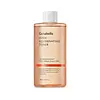What's inside
What's inside
 Key Ingredients
Key Ingredients

No key ingredients
 Benefits
Benefits

 Concerns
Concerns

No concerns
 Ingredients Side-by-side
Ingredients Side-by-side

Water
Skin ConditioningButylene Glycol
HumectantGlycerin
HumectantPropanediol
SolventNiacinamide
SmoothingDipropylene Glycol
Humectant1,2-Hexanediol
Skin ConditioningPanthenol
Skin ConditioningSodium Dna
Skin ConditioningCitric Acid
BufferingEthylhexylglycerin
Skin ConditioningAdenosine
Skin ConditioningXanthan Gum
EmulsifyingSodium Citrate
BufferingDisodium EDTA
Sodium Hyaluronate
HumectantPortulaca Oleracea Extract
Skin ConditioningCentella Asiatica Extract
CleansingHydrolyzed Vegetable Protein
Skin ConditioningMaltodextrin
AbsorbentBeta-Glucan
Skin ConditioningTocopherol
AntioxidantHyaluronic Acid
HumectantHydrolyzed Sodium Dna
Skin ConditioningHydroxypropyltrimonium Hyaluronate
Madecassoside
AntioxidantHydrolyzed Hyaluronic Acid
HumectantTripeptide-1
Skin ConditioningSodium Acetylated Hyaluronate
HumectantSodium Hyaluronate Crosspolymer
HumectantMadecassic Acid
Skin ConditioningHydrolyzed Sodium Hyaluronate
Skin ConditioningAsiatic Acid
Skin ConditioningAsiaticoside
AntioxidantAcetyl Hexapeptide-8
HumectantPotassium Hyaluronate
Skin ConditioningWater, Butylene Glycol, Glycerin, Propanediol, Niacinamide, Dipropylene Glycol, 1,2-Hexanediol, Panthenol, Sodium Dna, Citric Acid, Ethylhexylglycerin, Adenosine, Xanthan Gum, Sodium Citrate, Disodium EDTA, Sodium Hyaluronate, Portulaca Oleracea Extract, Centella Asiatica Extract, Hydrolyzed Vegetable Protein, Maltodextrin, Beta-Glucan, Tocopherol, Hyaluronic Acid, Hydrolyzed Sodium Dna, Hydroxypropyltrimonium Hyaluronate, Madecassoside, Hydrolyzed Hyaluronic Acid, Tripeptide-1, Sodium Acetylated Hyaluronate, Sodium Hyaluronate Crosspolymer, Madecassic Acid, Hydrolyzed Sodium Hyaluronate, Asiatic Acid, Asiaticoside, Acetyl Hexapeptide-8, Potassium Hyaluronate
 Reviews
Reviews

Ingredients Explained
These ingredients are found in both products.
Ingredients higher up in an ingredient list are typically present in a larger amount.
1,2-Hexanediol is a synthetic liquid and another multi-functional powerhouse.
It is a:
- Humectant, drawing moisture into the skin
- Emollient, helping to soften skin
- Solvent, dispersing and stabilizing formulas
- Preservative booster, enhancing the antimicrobial activity of other preservatives
Propanediol is an all-star ingredient. It softens, hydrates, and smooths the skin.
It’s often used to:
Propanediol is not likely to cause sensitivity and considered safe to use. It is derived from corn or petroleum with a clear color and no scent.
Learn more about PropanediolSodium DNA is an emerging anti-aging ingredient.
It is created by taking deoxyribonucleic acid (DNA) and purifying it with sodium hydroxide.
The DNA is extracted from several different animal sources, including: calf thymus, the gonadic tissue of a male sturgeon, or herring / salmon sperm.
You have probably seen this ingredient in anti-aging skincare. But what is it?
DNA is composed of nucleotides, or chemical building blocks. Nucleotides include adenine (A), thymine (T), guanine (G), and cytosine (C). Talk about a flashback to biology! Nucleosides are formed from these nucleotides.
The science behind Sodium DNA is based on an ingredient called Polydeoxyribonucleotide or PDRN.
PDRN are DNA fragments mainly extracted from the sperm cells of trout or salmon. Meaning, PDRN can be derived from Sodium DNA.
PDRN consists of chains of nucleotides and nucleosides mentioned above. They can range anywhere from 80 - 2000 pairs.
Studies show PDRN has the following properties:
Most of the research on PDRN has been done using injectable forms. That’s important, because PDRN is a large molecule and doesn’t absorb well through the skin. So if you’re applying it topically, the effects are likely to be much milder.
Still, topical Sodium DNA is emerging as a trendy anti-aging ingredient. It’s generally well-tolerated and offers good biocompatibility with human skin, making it a low-risk addition to most routines.
Further studies are needed to truly confirm this ingredients anti-aging ability (Remember, retinol has decades of research!).
When using this ingredient, is is best to ask a brand about the source of their Sodium DNA. You'll want to find products where the Sodium DNA is sourced from fish. Some Sodium DNA is derived from calf / cow thymus.
Needless to say, this ingredient is not vegan.
Learn more about Sodium DnaWater. It's the most common cosmetic ingredient of all. You'll usually see it at the top of ingredient lists, meaning that it makes up the largest part of the product.
So why is it so popular? Water most often acts as a solvent - this means that it helps dissolve other ingredients into the formulation.
You'll also recognize water as that liquid we all need to stay alive. If you see this, drink a glass of water. Stay hydrated!
Learn more about Water